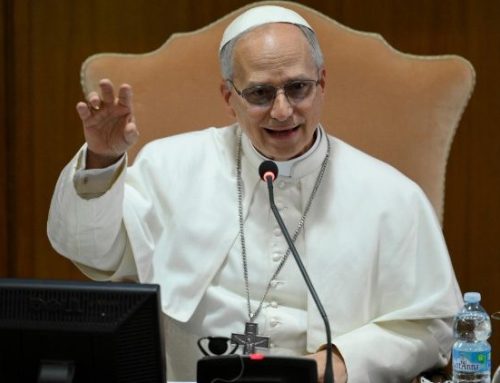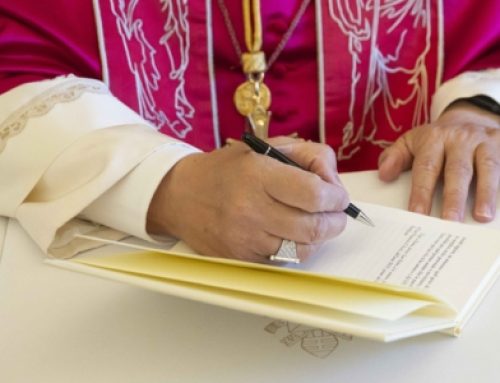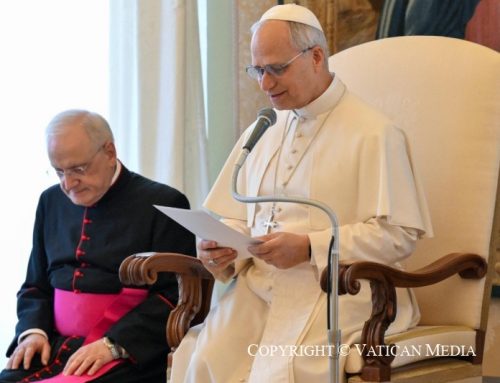Por Samuel Gregg
Fuente: Public Discourse
7 de diciembre de 2021
The second and final volume of a biography of Benedict XVI focuses on his place in addressing the crises shaking both the post–Vatican II Catholic Church and the West more generally.
Though the Second Vatican Council closed almost six decades ago, its meaning and teachings remain deeply contested today. Some of these debates may subside once the generation of Catholics formed in the Council’s immediate aftermath departs the earthly scene. What’s not in doubt, however, is that the Catholic Church in the West is a shadow of what it once was.
For all the happy talk of Vatican II ushering in an “adult church” and “new springtime,” the facts—ranging from declining participation in the sacraments in Western nations to the growth of church organizations indistinguishable in ethos and praxis from your average secular NGO—suggest a very different reality. Nowhere is this more evident than in contemporary German Catholicism. Few churches can match its tax-derived financial muscle or sheer number of employees. Yet over two hundred thousand Catholics formally leave the church in Germany every year. Moreover, if the German church’s Synodal Way is any indication, significant numbers of German clerics and laity plainly don’t believe in essentials of the Catholic faith. They appear determined to transform German Catholicism into yet another liberal religious confession that will surely encounter the fate of most such entities: bureaucratized oblivion.
German Catholicism’s present trajectory was predicted years ago by a theologian who became Archbishop of Munich, before serving twenty-three years as head of the universal Church’s doctrinal office, after which he was elected pope. Joseph Ratzinger perceived that German Catholicism’s self-destructive tendencies had roots that went deeper than disputes about Vatican II. For Ratzinger, the stakes concerned not only central Christian teachings like belief in the physical resurrection of Jesus Christ or the reliability of the Gospels as witnesses to Christ’s life and teachings. Issues that should concern believer and nonbeliever alike, such as whether truth is knowable beyond the empirical, were also in play.
This is the lens through which Peter Seewald approaches the second and concluding volume of his biography of Benedict XVI. In Benedict XVI: A Life, Volume Two: Professor and Prefect to Pope and Pope Emeritus 1966–The Present (2021), Seewald portrays Ratzinger as engaged in several struggles inside and outside the Catholic Church. By Seewald’s account, Ratzinger did not seek these out. Indeed, he is presented as the polar opposite of one of the book’s main protagonists: the Swiss theologian Hans Küng, from whom Seewald strips away all the mythology to reveal a publicity-hungry activist with a planet-sized ego for whom truth and facts were dispensable if they obstructed his agenda.
But like the first volume of Seewald’s Ratzinger biography that I reviewed in Public Discourse in early 2021, this book is not about a settling of scores. Seewald’s concern is to deepen understanding of Ratzinger’s life and thought within the context of seismic shifts in the world of ideas. In doing so, Seewald demonstrates Ratzinger’s significance for anyone who believes that there is truth that extends beyond the scientific and measurable.
From Germany to the Holy Office
Seewald begins volume two with the maelstrom that engulfed German Catholicism in Vatican II’s aftermath. Even readers well-versed in post–Vatican II Catholic history will be astonished at the pace whereby so much of the German church collapsed into a community caught up with the radical social movements of 1968, while it simultaneously slid into the complacency of what Ratzinger called “bourgeois religion.” By the latter, Ratzinger meant a religion in which people speak “endlessly about dialogue and structural change” but never quite get around to mentioning words like “God”—let alone explaining why people should care whether there is a Divinity whose love and reason permeate the universe. Instead, the priority is conformity to progressive secular expectations.
This combination of bourgeois religion and obsequiousness to secular ideologies could, Ratzinger argued from the mid-1960s onwards, only prove fatal to any religious tradition that embraced it. These trends in the Christian world threatened, Ratzinger maintained, to obscure the truth about Jesus of Nazareth. One of Ratzinger’s ways of fighting back was to speak very directly about who Christ was. In the process of doing so, one of Ratzinger’s major intellectual achievements was to recover Jesus as someone who is incomprehensible without understanding his Jewishness and the entire background of the Hebrew Scriptures.
Ratzinger’s emphasis on Jesus’s Jewish identity, Seewald emphasizes, was not primarily a response to the Nazi regime’s attempt to wipe the Jewish people off the face of the earth during World War II (though this was obviously an important background to his work). Ratzinger’s biographical excavations were a matter of seeking to know the full truth about Christ. The final fruits of this research were made manifest in Benedict XVI’s three volume Jesus of Nazareth (2008, 2011, 2012) which, to my mind, has played a significant role in rescuing Christ from the essential unknowability to which many post-conciliar Scripture scholars have tried to relegate him.
Alas, the bulk of Ratzinger’s time after the closing of Vatican II in 1965 was not devoted to scholarly enterprises. He was increasingly obliged to undertake tasks such as those associated with becoming Archbishop of Munich, which, Seewald stresses, Ratzinger did not especially enjoy and which sometimes required talents that, by Ratzinger’s own admission, he did not possess in abundance. Governance was not always Ratzinger’s forte. Nor, it turns out, was Ratzinger well-served by some of the people surrounding him in Munich or Rome. But Ratzinger had fewer struggles with management when he served as Prefect of the Congregation of the Doctrine of the Faith between 1982 and 2005. Seewald’s account suggests that this was the most significant and fruitful part of Ratzinger’s post–Vatican II life.
Into the Maelstrom
When Karol Wojtyła became pope in 1978, he quickly started pressing one of his electors, Cardinal Joseph Ratzinger of Munich, to become head of a major Curial office in Rome. Ratzinger politely rebuffed John Paul II at least twice before concluding that ongoing refusal would be viewed as obstinacy. It’s revealing, however, that Ratzinger made his appointment as head of the Catholic Church’s most important doctrinal office conditional on being allowed to continue researching and writing as a private theologian.
According to Seewald, Ratzinger never bothered to play the political games that have long preoccupied many who work in the Roman Curia. But, Seewald argues, Ratzinger quickly established his Congregation as the intellectual powerhouse of John Paul II’s pontificate, and it was through sheer intellectual firepower—not endless networking and empire-building—that Ratzinger emerged as a central force in the universal Church.
This did not mean that Ratzinger became the authoritarian censor that many theologians and German journalists of the time wanted us to believe. Ratzinger made a point of ensuring that due process was followed. Those whose views appeared to depart significantly from settled Catholic teaching on faith and morals were given numerous opportunities to state and explain their position. Nonetheless, Ratzinger insisted that Catholics had a right to know when a theologian’s position was inconsistent with Catholic faith. Many Jewish and Evangelical Christian thinkers, Seewald emphasizes, grasped this point far better than many a Catholic scholar. For Ratzinger, Catholic theologians were ultimately at the service of the Catholic Church’s faith—not the other way around. No faith can be a playground for advancing one’s academic career or building one’s “platform.”
The issues with which Ratzinger found himself grappling went far beyond the bounds of internal Catholic disputes. Whether it was the avalanche of bioethical questions that emerged in the 1980s or debates about the role of religious believers in the public square, such matters became major flashpoints throughout the West during Ratzinger’s time. Sometimes these were formally addressed by his Congregation. In other instances, Ratzinger penned articles or gave interviews in a private capacity that inevitably had a public impact. Seewald depicts Ratzinger as somewhat guileless in this respect. Given Ratzinger’s belief in the power of speaking the truth to expose the incoherence and often self-serving nature of erroneous positions, I find Seewald’s characterization less than convincing. I think Ratzinger knew exactly what he was doing.
Back to Logos
As scholars age, they often find themselves focusing on a few key ideas. Seewald maintains that Ratzinger paid more attention to a question that had always lain in the background of his work. Ratzinger plainly believed that this theme—the nature and ends of reason—was fundamental to the crisis in the Catholic Church and the Western world more generally. That focus emerged as a central plank of Ratzinger’s writings in his later years but also became a pivotal leitmotif of his pontificate.
One of the greatest misrepresentations of Ratzinger—again, propagated by German theologians and progressive journalists in the 1980s and the 1990s—is that he was essentially a reactionary, even an integralist. An hour or so spent perusing Ratzinger’s writings is enough to disabuse any inquiring mind of that fairy tale. Ratzinger admired a great deal of Enlightenment thought; he also had zero interest in the Church’s acquiring political power. On numerous occasions, Ratzinger made plain his conviction that close association with the state risked corrupting the Church. Nor did he hesitate to identify German Catholicism as exemplifying the problem.
Nonetheless, Ratzinger believed that religious believers should engage in public debate—but on the basis of reason. By “reason,” Ratzinger meant more than just the natural sciences. Human reason, he underscored, reflected the fact that men and women were made, as Genesis states, in the imago Dei: the same God identified in the first sentence of the Gospel of John as the Logos—Divine Reason.
One feature of late modernity, Ratzinger held, is that most of the postwar West had lost confidence in reason’s full capacities. This was manifest in the sentimental humanitarianism sweeping through many institutions of organized religion. It was also evident among scholars who exalted the importance of scientific rationality and yet were unable to recognize that the natural sciences themselves rest on axioms of a non-scientific character—including the logical principle of non-contradiction, and the self-evident truism that error is to be avoided while the truth is to be known. The end result was a West unable to understand itself, incapable of acknowledging its roots, and riddled with contradictions, such as proclaiming human rights while disputing the idea of objective moral truth.
In texts like his book Truth and Tolerance (2004) and his famous Regensburg address (2006), Ratzinger hammered away at these key points. In doing so, he elicited support from surprising sources. That included secular figures like the philosopher Jürgen Habermas and the Peruvian Nobel Laureate Mario Vargas Llosa. The latter called Ratzinger “one of the most significant intellectuals of the present day” and praised his “audacious new reflections” on the cultural problems of our time.
Ratzinger’s effort to rehabilitate reason, Seewald stresses, went together with a determination to bring the figure of Jesus of Nazareth back fully into the light. From Ratzinger’s perspective, the two themes went hand in hand, precisely because of the Christian conviction that the God first revealed to the Jewish people, and ultimately embodied in Jesus of Nazareth, is the fullness of reason itself.
Ratzinger’s pursuit of this project was conducted during some especially difficult challenges that arose during his pontificate—above all, the sexual abuse scandals. All in all, Ratzinger comes across as having performed reasonably well, albeit not perfectly, in confronting the problem. Seewald emphasizes that the pope wasn’t helped by considerable denial by many senior Catholic officials of the scale of the abuse, not to mention the web of corruption and mendacity spun through the Catholic hierarchy and Roman Curia by monsters like Marcial Maciel and Theodore McCarrick. These and other evils formed part of the cross that Ratzinger carried in the second half of his pontificate.
Humility at the Service of Truth
Ratzinger’s decision to resign the papacy is a choice for which he has been much criticized. Seewald, however, presents it as an act of reason: that once you recognize that your capacity to perform a particular role is fading, it is a mistake to pretend that your powers remain undiminished. Such a choice is not an act of weakness. On the contrary, it is an act of humility—a virtue that characterized Ratzinger from his time as an unknown teenager living in Hitler’s Germany to his service as pope in Rome.
In the short term, Benedict’s resignation may be the act for which his pontificate is remembered. Peter Seewald, however, illustrates that Joseph Ratzinger has bequeathed the Christian church—and anyone who cares about reason—a legacy that will long outlast the particularities of the present. In that regard, Ratzinger’s life is an example of why, in the dark and mediocre times in which we find ourselves, there is light for those who want to know and love the truth.





Deja tu comentario